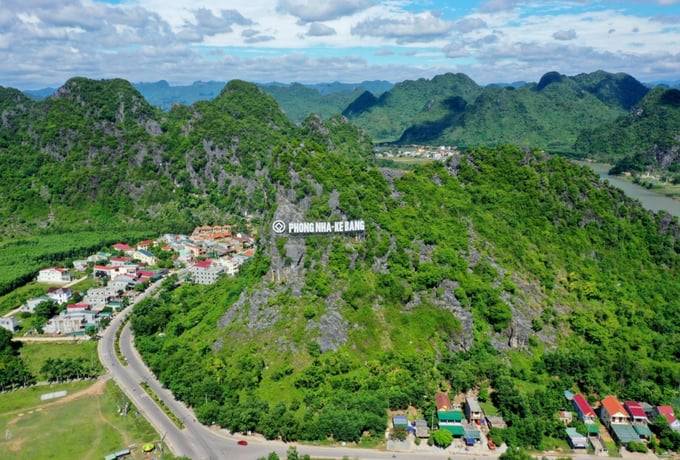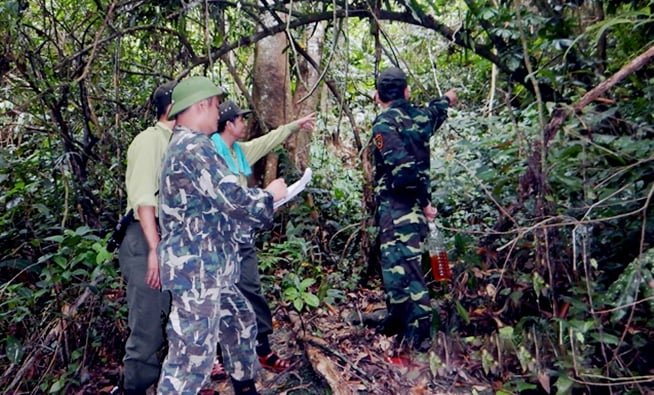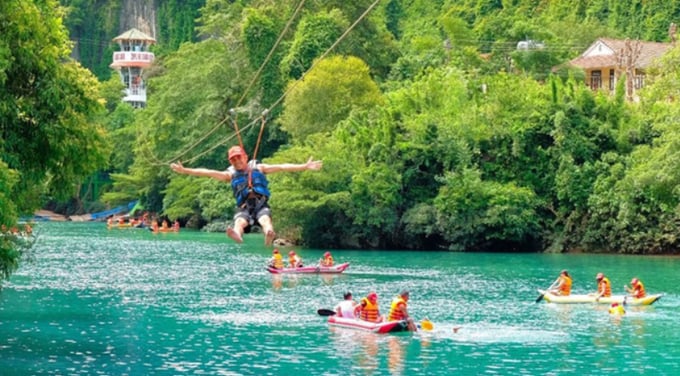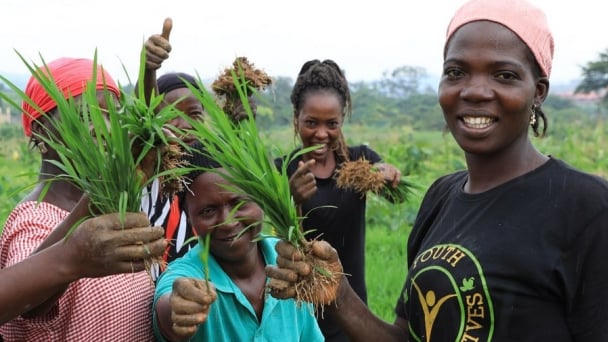May 15, 2025 | 11:44 GMT +7
May 15, 2025 | 11:44 GMT +7
Hotline: 0913.378.918
May 15, 2025 | 11:44 GMT +7
Hotline: 0913.378.918
With the assistance of the Vietnamese government and the international community, Phong Nha-Ke Bang National Park was enlarged to 123,326 hectares in order to preserve the largest ancient limestone region in Southeast Asia.
The United Nations Educational, Scientific, and Cultural Organization (UNESCO) voted on July 3, 2015, to add the criterion of outstanding values representing the evolutionary and developmental processes of terrestrial ecosystems with the most significant natural habitats for biodiversity conservation.
The World Natural Heritage is a significant landmark that not only recognizes its exceptional global value but also evaluates efforts to preserve resource values in their entirety.
Heritage recognition is the foundation for sustainable development based on the principle of harmony while promoting values and preserving natural resources in their entirety.

World Natural Heritage Phong Nha - Ke Bang National Park. Photo: H.T.
Therefore, over the past two decades, the Phong Nha - Ke Bang National Park Management Board has prioritized conservation management, scientific research, and the promotion of heritage values.
Over the past two decades, Phong Nha–Ke Bang National Park has designated forest protection as its primary and most important objective. As a consequence, the Park's administration has proposed measures to strengthen the main forces tasked with forest patrols, inspections, management, and protection.
The Phong Nha – Ke Bang Ranger Service has modified patrolling and inspecting the forest on a regular basis. It maintains coordination with local authorities and buffer zone residents to establish a confined corridor for the purpose of preventing negative impacts on the forest. In addition to the aforementioned duties, the unit has attracted the attention of the park's authorities for its use of technology in protection work.
Applications such as SMART, GIS, Drones, etc. have been utilized in forest protection, patrolling, biodiversity monitoring, earthquake monitoring, and assessing the human and natural consequences of natural disasters. Consequently, resource management is efficient and perpetually enhanced.
For the purpose of patrolling and safeguarding forests, forest rangers place an emphasis on raising public awareness and recognize that this is everyone's responsibility. At the same time, handle violations with determination.

The task of patrolling and protecting the forest is always given the top priority in Phong Nha-Ke Bang National Park. Photo: H.T.
The Phong Nha - Ke Bang National Park has organized more than 41 thousand patrols, management, preservation, and monitoring of biodiversity. This resulted in the discovery and removal of nearly 42,600 rope traps, the destruction of approximately 600 shelters, and a halt of more than 4,100 illegal forest entrants. Detected and issued a decision to rigorously manage 2,401 administrative violations in the field of forestry in accordance with the law...
Scientific research is regarded as the foundation of the conservation of resource values because the results of scientific research are always provable evidence that aids managers in making opportune decisions to intervene in order to preserve ecology.
Preliminary surveys in the Phong Nha - Ke Bang area have uncovered nearly 2,681 species of higher plants, including 208 species of orchids, many of which are uncommon and listed in the Red Book of Vietnam and IUCN. There are eight varieties of vegetation, including many characteristic forest community forest green Bach (calocedrus rupestris) limestone trees that are over 500 years old and constitute the greatest remaining population of primeval forest green Bach. Vietnam's allocation of more than 2,400 hectares of forest has significant significance for global conservation values.
Phong Nha-Ke Bang National Park is home to 154 mammal species, including the banteng largest species in the world, the tiger and the gaur; 303 species of birds, including 83 species in the Red Data Book of Vietnam and 110 species in the Red Book of the world; 100 species of reptiles; 51 classes of amphibians; 259 species of butterflies; 215 species of fish.
It also discovered 425 new caves in seven areas and systems, with 389 caves measuring a total of 243 kilometers in length.

Scientific research contributes to raising the value of heritage. Photo: H.T.
The most notable is the discovery of Son Doong, the world's largest cave, which is of great importance to caving research in the region and contributes significantly to the promotion of Vietnam, Quang Binh, and Phong Nha-Ke Bang tourism.
In addition to managing and preserving heritage values, the Phong Nha - Ke Bang National Park Management Board consistently prioritizes promoting the value of heritage through tourism activities, services, and investment solicitation.
With the understanding that tourism is the face and soul of Quang Binh tourism, Phong Nha-Ke Bang National Park has progressively diversified its tourism offerings and actively implemented all three images simultaneously. Implementation, joint venture, and licensing of forest environmental services are the organizational modes for tourism exploitation.
Phong Nha - Ke Bang National Park has 15 operational routes and tourist attractions that offer a wide variety of tourism options, including nature exploration, caves, camping, trekking, and zipline... Particularly, "Conquering Son Doong - the world's largest cave" is regarded as one of the best excursions in the world.

Develop tourism so that Phong Nha - Ke Bang National Park becomes an attractive tourist destination for domestic and foreign tourists. Photo: HT.
The expansion of services and tourism has attracted a growing number of heritage visitors. In the past 20 years, the total number of visitors to Phong Nha-Ke Bang National Park has exceeded 9.5 million, with international visitors exceeding 1.1 million. Revenue from fees and levies surpassed 1,742 billion Vietnamese Dong...
The designation of Phong Nha-Ke Bang National Park as a World Natural Heritage site presents both an opportunity and a significant propelling force for development, as well as challenges and pressures for park management.
The Management Board of Phong Nha-Ke Bang National Park has proposed solutions and orientations to carry out the task in the future, having a thorough understanding of the advantages, difficulties, and challenges involved in the process of completing the designated tasks.

The potential of tourism and investment links will make Phong Nha - Ke Bang National Park become the capital of adventure tourism. Photo: HT.
By 2025, the Park intends to transform the wildlife rescue area into a facility capable of receiving and rescuing multiple species to meet the needs of terrestrial wildlife rescue in the entire Central region. Continue to cultivate cooperative relationships with domestic and international organizations and scientists in order to obtain new discoveries that will enhance the value of cultural heritage.
Phong Nha-Ke Bang National Park concentrates on promoting the value of natural resources in a reasonable manner in order to develop diverse categories of tourism and tourism-related products by overcoming obstacles and challenges. Efforts are being made to transform Phong Nha-Ke Bang into the adventure tourism capital of Asia.
Translated by Linh Linh

(VAN) Data from 10,000 farming households will help professionalize production organization and support the implementation of the One Million Hectares Program for High-Quality, Low-Emission Rice Cultivation.

(VAN) FAO Director-General QU Dongyu marks International Day of Plant Health at NENA conference.

(VAN) Deputy Minister of Agriculture and Environment Hoang Trung affirmed that floriculture and ornamental plants are a growing industry that receives significant global attention.

(VAN) The three staple crops dominating modern diets – corn, rice and wheat – are familiar to Americans. However, fourth place is held by a dark horse: cassava.
/2025/05/10/4037-3-223011_495.jpg)
(VAN) Remote sensing technology is becoming an indispensable tool in monitoring resources, developing modern agriculture, and protecting the environment in Vietnam.

(VAN) The trash bag used on fishing vessels can withstand rough sea conditions, including level 8 to level 10 winds and waves. Notably, it can be hung anywhere on the boat.

(VAN) African leaders launched the Kampala Declaration on Building Resilient and Sustainable Agrifood Systems in Africa, marking a bold step toward transforming the continent's agriculture.